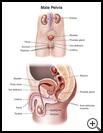
Transurethral Incision of the Prostate (TUIP)
What is transurethral incision of the prostate (TUIP)?
Transurethral incision of the prostate (TUIP) is a procedure to treat an enlarged prostate gland.
The prostate gland is part of a man's reproductive system. It is about the size of a walnut and located between the bladder and the penis. The prostate gland surrounds the upper part of the urethra, the tube that carries urine from the bladder out through the penis. It makes fluid that nourishes sperm and helps carry it out of the body during sex.
When is it used?
When the prostate gets bigger than normal, it may put pressure on the urethra and cause problems with urination. You may have trouble passing urine, and you may feel the need to urinate more often, sometimes even at night. The need to urinate can come on suddenly. In severe cases, you may not be able to pass urine. This can cause kidney damage if it is not treated promptly.
TUIP is a possible treatment if your prostate gland is not severely enlarged. It’s best to have this procedure before urine symptoms become severe or the prostate gland gets too large. Ask your healthcare provider about your choices for treatment and the risks.
How do I prepare for this procedure?
- Make plans for your care and recovery after you have the procedure. Find someone to give you a ride home after the procedure. Allow for time to rest and try to find other people to help with your day-to-day tasks while you recover.
- Tell your provider if you have any food or medicine allergies.
- You may go home with a catheter for a few days after the procedure. A catheter is a small tube used to drain urine from the bladder. It's best to learn about the catheter and urine collection bag before your procedure. Ask your healthcare provider about this.
- You may or may not need to take your regular medicines the day of the procedure. Tell your healthcare provider about all medicines and supplements that you take. Some products may increase your risk of side effects. Ask your healthcare provider if you need to avoid taking any medicine or supplements before the procedure.
- Your healthcare provider will tell you when to stop eating and drinking before the procedure. This helps to keep you from vomiting during the procedure.
- Follow your provider's instructions about not smoking before and after the procedure. Smokers may have more breathing problems during the procedure and heal more slowly. It is best to quit 6 to 8 weeks before surgery.
- Follow any instructions your healthcare provider may give you.
- Ask any questions you have before the procedure. You should understand what your healthcare provider is going to do. You have the right to make decisions about your healthcare and to give permission for tests or procedures.
What happens during the procedure?
This procedure is usually done at a surgical center or hospital.
You will be given medicine to help you to relax. The medicine can make you drowsy or you may fall asleep before the procedure.
You will be given medicine called anesthesia to keep you from feeling pain during the procedure. You may have:
- Regional anesthesia, which numbs the lower part of your body.
- General anesthesia, which relaxes your muscles and you will be asleep. A breathing tube is usually put in your throat when you have general anesthesia.
Your healthcare provider will pass a thin, lighted tube through the urethra and into the bladder. Fluid will be passed into the bladder to stretch the bladder and help your provider see the area better. With the scope, your provider will be able to see the area where the enlarged prostate is causing problems.
Your provider will make several deep cuts through the bladder neck and into the prostate gland to relieve the pressure on the urethra. Then, while you are still numb, your provider will insert a catheter into the penis and the urethra and then into the bladder. The catheter will help the bladder drain and flush out any blood clots that may have formed. The urethra will swell after the surgery and the catheter will help it stay open.
What happens after the procedure?
After the procedure you may stay in a recovery area for at least a few hours. You may be able to go home the day you have the procedure or you may stay in the hospital overnight.
You will likely have some pain or discomfort in the area over your bladder, as well as at the base of your penis. The catheter in the urethra normally needs to stay in for 2 to 3 days. Do not try to remove the catheter. Your healthcare provider will remove the catheter.
Ask your healthcare provider:
- How long it will take to recover
- If there are activities you should avoid, including lifting, and when you can return to your normal activities
- How to take care of yourself at home
- What symptoms or problems you should watch for and what to do if you have them
Make sure you know when you should come back for a checkup. Keep all appointments for provider visits or tests.
What are the risks of this procedure?
Every procedure or treatment has risks. Some possible risks of this procedure include:
- You may have problems with anesthesia.
- You may have infection, blood clots, or bleeding.
- It may be harder for you to have an erection. Also, when you have an orgasm, semen may not come out of your penis. Instead it may flow backward into your bladder.
- Rarely, you may have trouble controlling your urine.
Ask your healthcare provider how these risks apply to you. Be sure to discuss any other questions or concerns that you may have.

